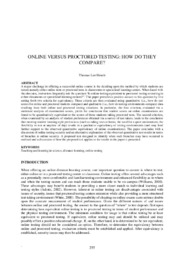| dc.contributor.author | Hench, Thomas Lee | en |
| dc.coverage.spatial | CY - Λευκωσία | en |
| dc.creator | Hench, Thomas Lee | en |
| dc.date.accessioned | 2016-02-10T06:10:22Z | |
| dc.date.available | 2016-02-10T06:10:22Z | |
| dc.date.issued | 2005 | |
| dc.identifier.uri | http://hdl.handle.net/10797/14619 | en |
| dc.description | Περιέχει το πλήρες κείμενο | el |
| dc.description.abstract | A major challenge in offering a successful online course is the deciding upon the method by which students are tested; namely either online tests or proctored tests in classrooms or specialized learning centers. When faced with this decision, instructors frequently ask the question “Is online testing equivalent to proctored testing occurring in either classrooms or specialized learning centers?”. This paper provides a positive answer to this question by first setting forth two criteria for equivalency. These criteria are then evaluated using quantitative (i.e., how do test scores for online and proctored students compare) and qualitative (i.e., how do testing environments compare) data resulting from both online and proctored testing situations. In particular, the first criterion, evaluated via a statistical analysis of examination scores, yields the conclusion that student scores on online examinations are found to be quantitatively equivalent to the scores of those students taking proctored tests. The second criterion, when examined by an analysis of student preferences obtained via a survey of test takers, leads to the conclusion that meeting student learning style preferences (such as taking tests at home, the need for a quiet environment, the flexibility to test at anytime of day) results in a qualitative equivalency of testing environments (and may lend further support to the observed quantitative equivalency of online examinations). The paper concludes with a discussion of online testing security and an alternative explanation of the observed quantitative test results in terms of breaches in online security. A proposed test designed to identify when such breaches may have occurred is outlined and a discussion of how the proposed test applies to the results in the paper is presented. | en |
| dc.language.iso | eng | en |
| dc.publisher | University of Zilina | en |
| dc.relation.ispartof | Testing/Assessment | en |
| dc.rights | info:eu-repo/semantics/openAccess | en |
| dc.rights | Open Access | en |
| dc.source | CBLIS Conference Proceedings 2005 Integrating New Technologies in Science and Education | en |
| dc.title | Online versus proctored testing: how do they compare? | en |
| dc.type | info:eu-repo/semantics/conferenceObject | en |
| dc.subject.uncontrolledterm | Teaching and learning in science | en |
| dc.subject.uncontrolledterm | Distance learning | en |
| dc.subject.uncontrolledterm | Online testing | en |
| dc.contributor.conferenceorganizer | Learning in Science Group, University of Cyprus | en |
| dc.contributor.coordinator | Constantinou, Constantinos P. | en |
